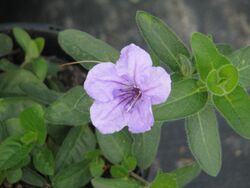Biology:Ruellia humilis
| Ruellia humilis | |
|---|---|

| |
| Scientific classification | |
| Kingdom: | Plantae |
| Clade: | Tracheophytes |
| Clade: | Angiosperms |
| Clade: | Eudicots |
| Clade: | Asterids |
| Order: | Lamiales |
| Family: | Acanthaceae |
| Genus: | Ruellia |
| Species: | R. humilis
|
| Binomial name | |
| Ruellia humilis Nutt.
| |
| Synonyms | |
| |
Ruellia humilis (wild petunia,[1] fringeleaf wild petunia,[2] hairy petunia, low wild petunia) is a species of flowering plant in the family Acanthaceae. It is native to the eastern United States .[1] It is grown as an ornamental plant.[3]
Ruellia humilis is native to the U.S. from the northeastern/northern central to the southeastern/southern central regions. According to the Germplasm Resources Information Network of the United States Department of Agriculture, Ruellia humilis is native to the following states:[1]
Alabama, Arkansas, Georgia, Illinois, Indiana, Iowa, (eastern) Kansas, Kentucky, Louisiana, Maryland, Michigan, (southeastern) Minnesota, Mississippi, Missouri, Nebraska, (western) North Carolina, Ohio, Oklahoma, Pennsylvania, Tennessee, (eastern) Texas, West Virginia, Wisconsin, and Virginia.[1]
It is not well-known or used much in conventional nurseries or gardens, but use in gardens has been increasing as native plants become more popular.[citation needed] It is usually about one foot high, but can get to two feet high. Its opposite leaves are to 2.5 inches long by 1 inch wide and are light green to medium green with smooth margins and are covered with soft white hairs on both sides. The funnel-shaped 5-lobed flowers are about 1.5 to 2.5 inches in diameter and do resemble petunias, as does the rest of the plant. The lavender flowers bloom in July into September and open in the morning and fall off in the evening.[citation needed]
Ecology
Ruellia humilis grows in dry to average soil in full sun to part shade conditions. Its habitats include prairies, glades, meadows, and open woodland environments. It grows well in dry, shallow, and rocky soils.[4][5] It has been observed to have a high level of richness of arbuscular mycorrhizal fungi(AMF) diversity when located in calcareous plots as compared to acidic plots.[6]
With the general exclusive presence of Ruellia humilis in the United States set, there is more data that indicates, more specifically, the type of biome and regions that this plant shows up in more often. One case study sampling from Buettner Xeric Limestone Prairies, Illinois, Monroe County revealed that when comparing frequency of the plant, the plant had 70% presence in the eastern region of prairie and only 3% in the western region prairie. To place this data in perspective, the eastern region's vegetation covered about 38% of the surface while the western region's vegetation covered about 33.5% of its surface. Both regions' "rock was between 17% and 19%, and bare ground and litter was from 40% to 44%."[7]
As host plant
This plant is a host plant for the common buckeye butterfly.[4]
References
- ↑ 1.0 1.1 1.2 1.3 {{citation | mode = cs1 | title = Ruellia humilis | work = Germplasm Resources Information Network (GRIN) | url = | publisher = [[Organization:Agricultural Research ServAgricultural Research Service (ARS), United States Department of Agriculture (USDA) | access-date = 14 January 2018 }}
- ↑ "Ruellia humilis". Natural Resources Conservation Service PLANTS Database. USDA. https://plants.usda.gov/core/profile?symbol=RUHU. Retrieved 25 October 2015.
- ↑ Ruellia humilis. Missouri Botanical Garden.
- ↑ 4.0 4.1 Mooney, Joseph. "Native Plant of the Week: Wild Petunia". https://mbgna.umich.edu/native-plant-of-the-week-wild-petunia/.
- ↑ "Ruellia humilis". https://www.missouribotanicalgarden.org/PlantFinder/PlantFinderDetails.aspx?kempercode=m220.
- ↑ Tipton, Alice G.; Middleton, Elizabeth L.; Spollen, William G.; Galen, Candace (January 2019). "Anthropogenic and soil environmental drivers of arbuscular mycorrhizal community composition differ between grassland ecosystems" (in en). Botany 97 (1): 85–99. doi:10.1139/cjb-2018-0072. ISSN 1916-2790. http://www.nrcresearchpress.com/doi/10.1139/cjb-2018-0072.
- ↑ McClain, William E.; Ebinger, John E. (December 2014). "Vascular Flora of Buettner Xeric Limestone Prairies, Monroe County, Illinois". Castanea 79 (4): 246–254. doi:10.2179/14-015r. ISSN 0008-7475. http://dx.doi.org/10.2179/14-015r.
Further reading
- Blanchan, N. (2002). Wild Flowers: An Aid to Knowledge of our Wild Flowers and their Insect Visitors. Project Gutenberg Literary Archive Foundation.
Wikidata ☰ Q814412 entry
 |


